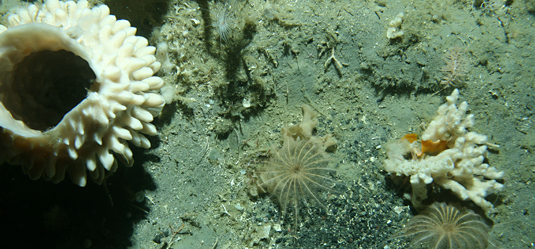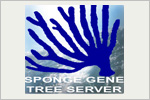DNA barcoding discloses diversity
LMU-Wissenschaftler haben DNA-Erkennungssequenzen antarktischer Schwämme analysiert und neue Einblicke in deren Artenvielfalt und Evolutionsgeschichte erhalten.
30.06.2015

Antarctic sponges. Picture: DTIS camera, IPY-CAML project, National Institute of Water and Atmospheric Research, New Zealand.
Sponges constitute an important component of marine ecosystems in the waters around Antarctica. As filter feeders that rely on food particles suspended in the water passing through complex networks of canals lined with flagellated cells, they provide protected niches for many other organisms. “In spite of their considerable ecological significance, Antarctic sponges have never before been investigated with modern molecular methods, which permit rapid and unambiguous species identification and yield insights into the evolution of the group,” says Professor Gert Wörheide (Chair of Palaleontology and Geobiology at LMU). He and his international team, including colleagues from New Zealand, have now remedied this deficiency by performing the first comprehensive analysis of species-specific genetic signatures among sponges collected from the Ross Sea in Antarctica. The new study appears in the online journal PLOS ONE.
Some 350 species of sponge have been described from the seas around Antarctica, many of which occur nowhere else. The high proportion of endemic species most probably reflects the isolation of the continent, which separated from Gondwana around 140 million years ago. Progressive cooling of the climate, together with the development of the Antarctic Circumpolar Current, set up effective barriers to dispersion, and likely have stimulated ecological specialization. “However, investigation of the evolutionary history and ecology of these sponges has been greatly impeded by the fact that DNA data are available for only about 2% of all Antarctic species,” says Dr. Sergio Vargas, first author of the new study.
Tropical richness in a cold climate
Wörheide’s team has now carried out the first comprehensive molecular genetic survey of sponge diversity in the Antarctic sponges, using the method of DNA barcoding. This involves determination of the nucleotide sequence of a short stretch (about 600 bp long) of a mitochondrial gene that is present in all animal species but has diversified over evolutionary time. The sequences therefore serve as species-specific identification tags, quite similar to the barcodes used to tag and track the products on the shelves of your local supermarket. DNA barcoding thus permits rapid and reliable identification of organisms at the species level. Moreover, the differences between the different sequences can be used to reconstruct the evolutionary relationships between different species.
The barcoding exercise revealed that Antarctic sponges are a highly diverse group. In fact, the degree of species richness found in the waters around the coldest continent is comparable to that present in tropical sponge communities. The genetic analyses support the idea that Antarctic sponges developed as a largely isolated population, most of which probably descended from a small number of ancestral forms that evolved in the waters off Gondwana prior to the break-up of the supercontinent. Some species of Antarctic sponges are known to be widespread on the continent's coasts, but very little is so far known about the genetic relationships between them. “Our results make it possible to create a library of DNA barcodes, which can be used for comparative investigations of the group. We can determine, for instance, whether an ostensibly circumpolar species actually represents a single species or a collection of diverse local forms,” Wörheide says. “Such information is of great significance for the conservation and management of the marine resources in the seas around this unique landmass, which is acutely threatened by global climate change.”
göd





